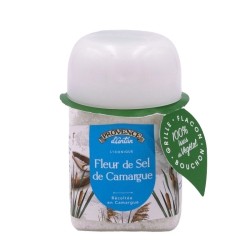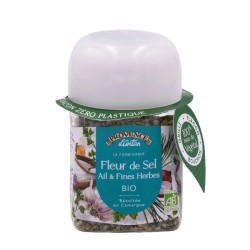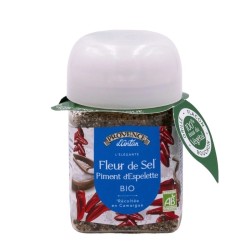
The Salt Marshes of Aigues-Mortes in Camargue.
1. Introduction
The Salins d'Aigues-Mortes, a salt gem of the Camargue, reveal a centuries-old history inscribed in the Peccais marshes, located southeast of the fortified village of Aigues-Mortes, in the Gard department.
This article delves into the geographical, historical, and productive intricacies of this exceptional site, offering a comprehensive view of the evolution of salt exploitation from antiquity to the present day.
Geographical and historical significance of the region
Perched on the municipality of Aigues-Mortes, the Salins extend over a vast canvas, dotted with basins and imbued with a palpable historical aura.
Accessible via departmental road 46, these salt flats adjoin the Marais de Peccais, an ecosystem where pink flamingos make their home along the lakeshores.
This privileged location adds a unique visual dimension to the salt flats, offering captivating aerial views from the skies of Gard.
Life of flamingos at the edge of the lake
The pink flamingos, emblematic of the region, lend a special atmosphere to the Salins d'Aigues-Mortes.
Their graceful silhouettes harmonize with the reflections of the salted waters, adding a touch of elegance to this saline landscape.
Exploring the Salins, one discovers the fascinating interaction between this majestic bird and the saline ecosystem, a natural ballet that transcends time and testifies to the preserved biodiversity of the Camargue.
Let us now delve into the history of the Salins d'Aigues-Mortes, where salt economic activity dates back to ancient times, shaping the identity and heritage of this Camargue land.
2. Geography of the Salins d'Aigues-Mortes
Precise location in the municipality of Aigues-Mortes, in the Gard department The Salins d'Aigues-Mortes, majestically located in the municipality of Aigues-Mortes, reveal their imposing presence in the Gard department, a region steeped in history and tradition.
Nestled in the heart of the Marais de Peccais, these salt flats occupy a strategic position southeast of the fortified village, offering a unique geographical tableau that has evolved over the centuries.
Access to the salt flats via departmental road 46
To penetrate the saline universe of Aigues-Mortes, let us take departmental road 46, which winds through the Camargue landscape.
This access road, not only functional but also picturesque, gradually reveals the extent of the Salins.
It is the key to a world where salt exploitation has shaped the territory, leaving behind a rich geographical and cultural heritage.
Life of flamingos at the edge of the lake
The Salins d'Aigues-Mortes are not only the scene of salt production but also the privileged residence of pink flamingos.
These emblematic waders, symbols of Camargue fauna, find refuge along the shores of the salted lakes, creating a singular cohabitation between nature and human activity.
The aerial views of the Salins offer a unique spectacle where wildlife and industry harmoniously coexist, bearing witness to the preserved biodiversity of this region.
Let us now explore the intricacies of the history of the Salins d'Aigues-Mortes, delving into a past where salt has shaped the economy and destiny of this corner of the Camargue.
3. History of the Salins d'Aigues-Mortes
Ancient origins of salt exploitation
The history of the Salins d'Aigues-Mortes is rooted in the intricacies of antiquity, where salt exploitation takes root.
Attributed to Peccius, a Roman engineer whose name permeates the Peccais marsh, this initial activity lays the foundations for an industry that will endure through the centuries.
Evolution during the Middle Ages and influence of the Abbey of Psalmodie In the Middle Ages, as Aigues-Mortes is heavily influenced by the Abbey of Psalmodie, the local economy turns towards fishing and salt flats.
Under the reign of Louis IX, the drainage of the marshes, under the domination of the abbey, facilitates activities and trade.
A transformation that will lay the groundwork for local economic development.
Drainage of the marshes under Louis IX and development under the reigns of Philip III and Philip IV
The time of Louis IX marks a decisive turning point.
Under his rule, part of the marshes is drained to promote the development of regional commercial activities.
The successive reigns of Philip III, called the Bold, and Philip IV, called the Fair, contribute to the creation of the ramparts of Aigues-Mortes, thus highlighting the strategic and economic importance of the region.
Modern era and industrial revolution: from Louis XIV to the present day
The modern era sees the acceleration of salt production, particularly under Louis XIV, whose ambitions for the Salins d'Aigues-Mortes lead to significant investments.
With the advent of the industrial revolution, salt becomes a strategic resource, and production techniques are modernized.
From the 19th century to the present day, the Salins d'Aigues-Mortes have continued their production, adapting to technological and environmental challenges.
This resilience testifies to the vitality and endurance of an activity that has left an indelible mark on the Camargue landscape.
4. Conclusion
The Salins d'Aigues-Mortes, a living testimony to the economic and historical heritage of the Camargue, stand as a tribute to the men and women who, over the centuries, have shaped and perpetuated the activity of salt exploitation.
From antiquity to the present day, the evolution of the Salins reflects the resilience and adaptability of an industry that has weathered the tides of time.
As the pink flamingos gracefully populate the shores of the salted lakes, the Salins d'Aigues-Mortes continue to captivate visitors, offering a unique journey through the history and geography of this exceptional site.











